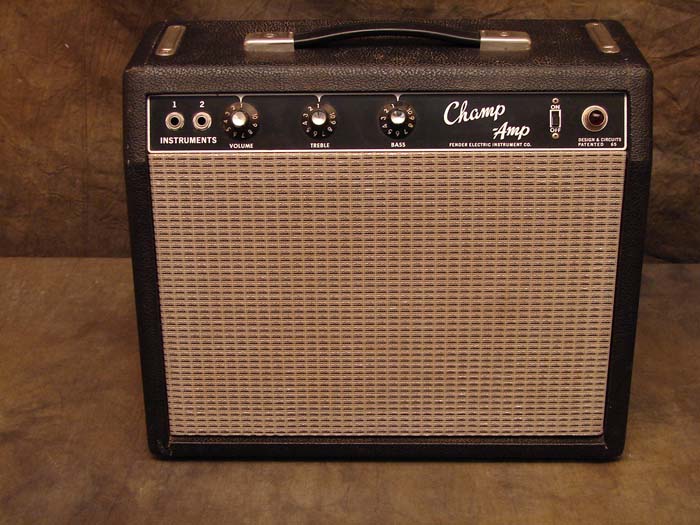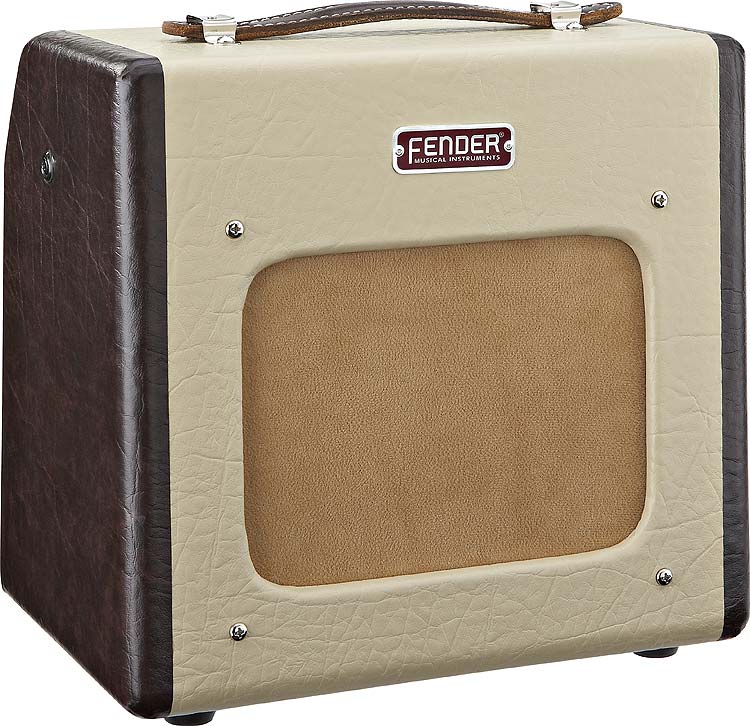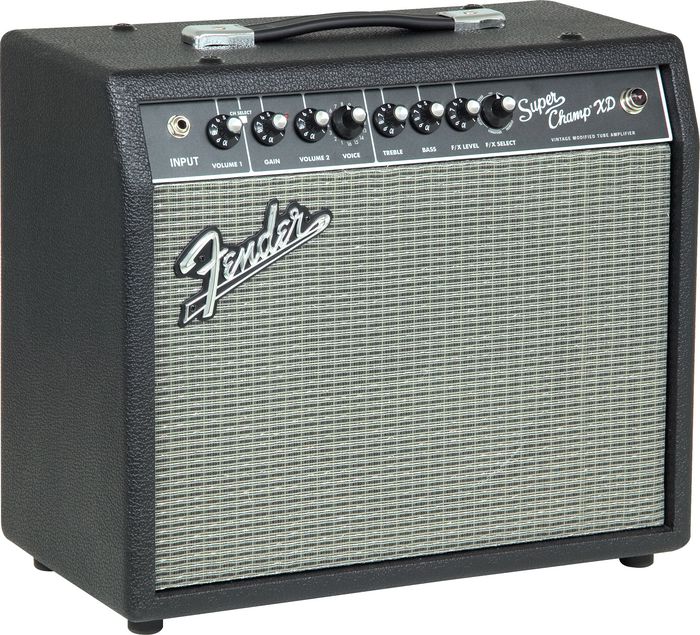Though they were meant to be student amplifiers for home use, players have found out, they make excellent recording amps and even sound great when miked. Cranked up and miked, these amps sound like a 50-watt Marshall.
The Champ is Fenders only Class A amplifier. Most Fender amplifiers come with two to four power tubes and operate in Class AB mode. This means the amp comes with a phase inverter tube (usually a 12AX7) that oscillates the power between the two power tubes, or two pairs of power tubes in high watt amps. This lessens the load on the power tubes and makes the amp run more efficiently.
The Champ has but one 6V6 power tube and therefore a phase inverter tube is unnecessary. The Champs power tube runs hot at 100% when the amp is running. Some players that believe this gives a punchier sound. Tom Jennings and Dick Denney, the creator of Vox amps, utilize Class A in most of the British made Vox AC line.
The oldest Fender Champ design was the Fender Champion 600. It had it’s beginnings in 1949 and was in the line for four years. Most of us are familiar with it due to the Chinese reissue. The 600, model 5B1 was a very minimalistic amplifier. It came with only one control, a volume control that went from 1 to 12 and served as an on/off switch, mounted on the amps rear along with the fuse and pilot light, along with two inputs. The knob on this potentiometer was known as the chicken-head variety.
The tube configuration featured a 5Y3 rectifier, a metal envelope 6V6 power tube, and a metal envelope 6SJ7 pre-amp tube. The electronics produced four watts of sound into a Jensen 6” Special Design speaker.
The cabinet came with a large leather luggage strap. The chassis was angled in the back and covered with a brown metal plate, that had white silk screened lettering.
It is interesting to note on the new version of the Champion 600, the rectifier is solid state, the power tube is a 6V6 and the preamp is a 12AX7. The tubes are glued to their bases to prevent rattling.
The original Champion 600 sold for $49.95 (today’s Chinese model goes for $149.95). In 1949 dollars, 50 USD was expensive.
The Champions cabinet underwent a design change in 1953 to go along with the larger amps in the Fender line-up. The cabinet now was the so-called wide panel tweed model or model 5C1. This may be the most collectible amp in the Champ line.
Except for the slightly larger cabinet, the speaker grill material, and the size of the grill, not much inside the amplifier was different. The same tube configuration existed, however they were glass tubes instead of metal envelope tubes, The speaker was still 6” and made by Jensen.
Up through 1955 the amp was labeled as the Champion 600. In 1955, the name underwent and update to The Champ Amp and the model became the 5D1.
In 1956, Fender changed the look of its amplifier line. They adopted the narrow panel tweed look. This held true for the Champ line. Fender designated this model as the 5E1 until 1956 when it listed as the 5F1 model. This style held its own up through 1964.
This amp underwent some changes from the prior models. The most striking was the control panel now mounted on top of the amp was chrome plated instead of painted brown.
The lettering was black. The controls were similar to the other models; just a single volume/on-off knob, a pilot light, a 2-amp fuse and two inputs. Depending on the model year, the carrying strap underwent some changes. Originally, it was the leather luggage style strap, this became a leather fold-down strap and finally in 1964 it was made of black plastic that folded down, typical of today’s Fender amps.
The speaker started as a 6” Jensen, but as the years went by, it became an 8” Jensen.
The tweed material covering the amp lasted through 1964 when it changed to the familiar black tolex. 1964 brought about a change in the grill covering. From 1955 until 1963, the covering was dark brown material. Fender changed this to white/silver/black woven material in 1964.
The tubes underwent an update. The rectifier remained the 5Y3. A 6V6GT became the power tube and a 12AX7 filled in as a preamp tube. This added an additional watt to the power rating, bumping it up to 5 watts.
By 1964, Fender amplifiers underwent a total redesign to what is known as Blackface models. The control panel and inputs moved to the front of the amplifier to allow easy access for the player.
The chassis was angled in the control section and a black plate with white screened lettering covered the control section. The cabinet was slightly larger and covered in black Tolex.
| Non original speaker |
The controls were numbered 1 – 10 (instead of 1 – 12). The tube configuration included a 5Y3 rectifier, a 6V6GT power tube, and a 12AX7 preamp tube that pumped out 6 watts. The fuse was underneath the chassis. The speaker cable hooked into a jack on the chassis’ underside.
Black skirted knobs that had a chrome center replaced the chicken-head knobs. The strap was made of plastic. This style was manufactured from 1964 through 1967.
By 1968, CBS was running the factory and the amplifiers were revamped with a new look. The black front plate was replaced with a silver front plate. Hence the name Silverface models.
The lettering was in a blue Arial font block letters, instead of the classic script. The badge on the grills front remained in large silver lettering.
The style of the badge changed as the years went by, from having a “tail” off the final letter “R” that underlined Fender, to not having a tail. The grill changed slightly as well. On early models, the grill covered the speaker baffle. In later years, Fender used a detachable frame covered with grill cloth, which attached to the baffle by means of Velcro.
This was designated model AA764. The tube configuration changed slightly. The 5Y3 rectifier and the 6V6GT power tube remained, but a 7025 now was the preamp tube. The cabinet covering once again was black Tolex. This model was in production for the longest period of any of the Champ line. It was available from 1968 to 1982.
The Fender Vibro Champ was also changed during these years to a silver-face model with the same features as the Black-face amplifier. The Silver-face Vibro Champ utilized the same 12AX7 as the Black-face model.
In 1982 the Fender Champ underwent a radical change. Fender acknowledged the work Randall Smith had done in modifying Fender Princetons and Champs with larger transformers, speakers and added power. Paul Rivera was now on the Fender designed team. For two years, 1982 and 83, the Fender Champ II became part of the line-up.
This little beast produced a respectable 18 watts. The control panel, once again, was black with white lettering. Instead of three knobs, a fourth was added for master volume. The Treble knob also pulled out to allow for a mid-range boost. The knob design remained the skirted version with chrome centers. The amp included a hum control on the rear of the chassis.
The Fender Blue-Frame speaker enlarged to 10 inches. It was boosted to 8 ohms, instead of the previous 3.5 ohms. The amplifier utilized a solid-state rectifier (as did most Fenders) and a pair of 6V6GT power tubes and a pair of 7025 preamp tubes. The amp was now Class AB.
During this same era, another Rivera creation was the Fender Super Champ. This amp lasted from 1982 through 1985. It was somewhat similar the Fender Champ II with the addition of reverb.
Like on other Fender reverb amps, the rear of the chassis had two jacks labeled reverb out, reverb in for the chords coming from the Hammond reverb unit on the cabinets’ floor.
The controls had changed. They were labeled, Volume (pull for lead), Treble (pull for mid), Bass, Reverb, Lead Level, and Master. The amp had only one input, but came with a separate headphone output. The pilot light was red. Like the Champ II, the amp came with a 10” Blue Frame Fender speaker, although Fender utilized Eminence and EV as well. The grill covering was the white/silver/black sparkle material on this amp and the Champ II model. The covering material once again, was black Tolex.
In 1983, Fender issued a limited Pro model of this amplifier, known as the Fender Super Champ Deluxe. Only 100 of these amps were manufactured. The cabinets were not covered in Tolex, but made of polished oak. The chassis panel on this model was brown, instead of black. This is a highly desirable collector’s amplifier, due to its limited run.
It was not until 1987 that Fender changed the Champ design. This now was the Fender Champ 12. This amp produced 12 watts into a 12” Fender Blue Label speaker. The tube configuration, included one 6L6 power tubes and twin 7025 preamp tubes. According to one alert reader, the tube diagram within the amp stated 12AX7 preamp tubes. Either tube would work. The rectifier was solid state. Because there was only one power tube, this amp runs in class A mode.
The cabinet was available with quite a few different coverings. These were Black, Red, White, Grey, or Tweed Tolex. Fender even offered snakeskin Tolex. The front panel was a black covering with white letters that housed twin input jacks and red knobs. The controls were Treble (pull for mid boost), Bass, Volume, Gain and Volume (labeled overdrive and Reverb. There were two input jacks for Tape in and a one volt line out jack. Additionally the amp had a stereo headphone jack.
The grill cloth material for this model came in a grey cloth. The amps production lasted through 1992.
The Fender Champ SE was manufactured from 1992 through 1994. This was the loudest of all the Champ Amps producing 25 watts of power into a 12” – 8-ohm Fender speaker.
The rectifier was solid state. The preamp section was also solid state. The amp utilized twin 6L6GC power tubes and one 12AX7 that acted as a phase inverter. This was similar to the Music Man amps that Leo Fender made after leaving Fender. The cabinet changed to a box design without a slanted control panel.
The amp controls were divided into two sections, one for clean tones and one for overdrive. These knobs were Volume, Treble, Bass, Mid and a push-push switch for Mid boost. The overdrive section knobs were Drive, Volume, Gain, Treble, Bass, and Contour. Another section was labeled Master Volume and Reverb. The amp had two input jacks on its right side and Effect Out, Effect In and Line Out on the left side. The amp included an on/off power switch as well as a standby switch.
I’ve already mentioned the modern Chinese made reproduction of the Fender Champion 600. The electronics in this amp are updated versions the original. The rectifier on this model is solid state. This uses a 6V6 power tube and a 12AX7 for its preamp tube. The gain is set higher than on the original Champion 600. Players seem to love this amplifier. The simplicity allows for a variety of sounds. The speaker is a 6" model, like on the original.
Fender also presented the Vibro Champ XD and the Super Champ XD.
The Vibro Champ XD utilizes a single 6V6GT tube for its power section and a single 12AX7 preamp tube. The speaker is 4 ohms, which is quite similar to the original. It produces 5 watts of power.
The amp is a Class A hybrid, meaning that it is both a tube amp and a solid-state amp. The amp comes with a voice control that yields a multitude of differing and useful amplifier models. The clean section is the tube amp. The overdriven and distorted tones come from the solid-state portion of the amp. The amp also features a unique effects section. It is an interesting concept.
The Super Champ XD is somewhat similar to the smaller Vibro Champ model, however this amplifier is a Class AB hybrid.
The amp utilizes twin 6V6GT power tubes, a solid-state rectifier, and one 12AX7 that does double duty. This tube is a dual triode tube. One half of the tube is used as a phase inverter for the power tubes and the other half is used as a preamp tube. Both channels of the amplifier pass through the preamp tube section.
The amp has two distinct channels. The clean section is 100% a tube amp and has only a Volume control. Pushing a channel switching control button on the front activates the Gain section, which includes controls for Gain, Volume 2 and Voice. This section is solid-state.
The voice control offers the same 16 different amp selections as the Vibro-champ. The Treble, Bass, FX Level and FX control works on both channels. This is an interesting and well thought out amplifier.






















Tidak ada komentar:
Posting Komentar